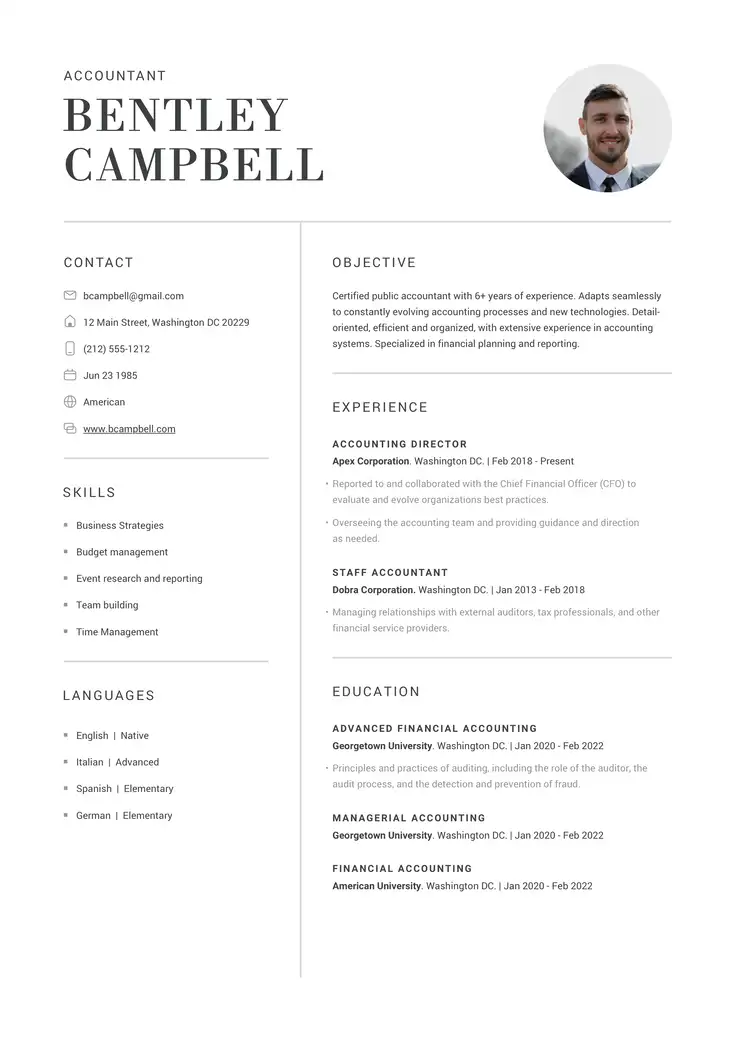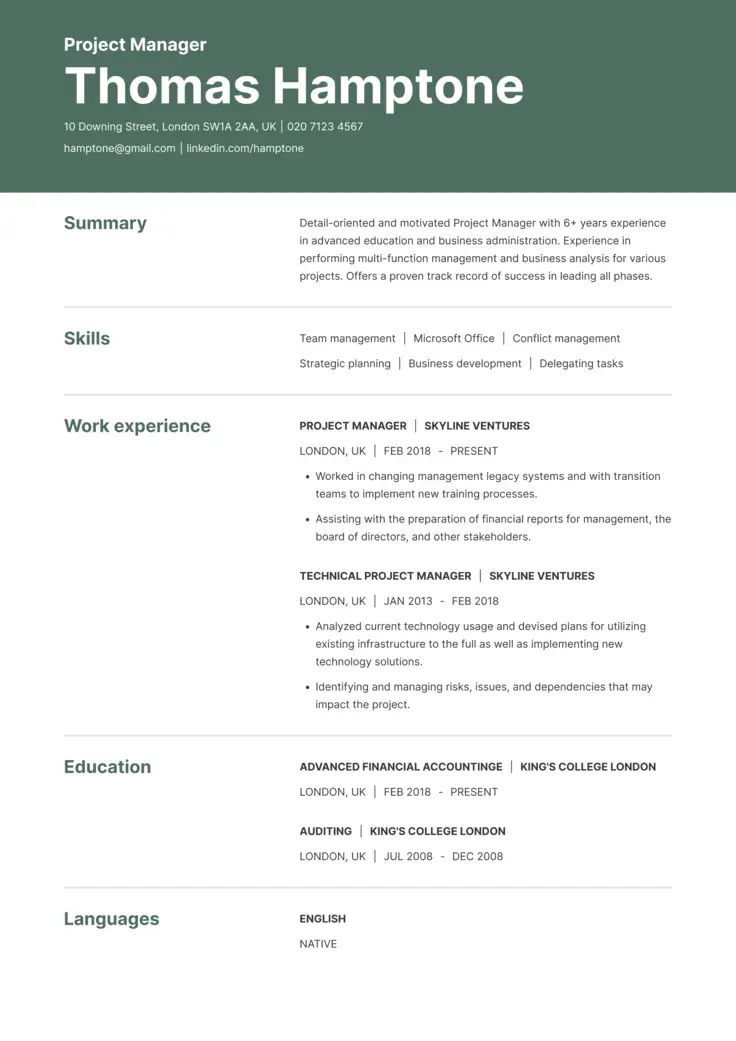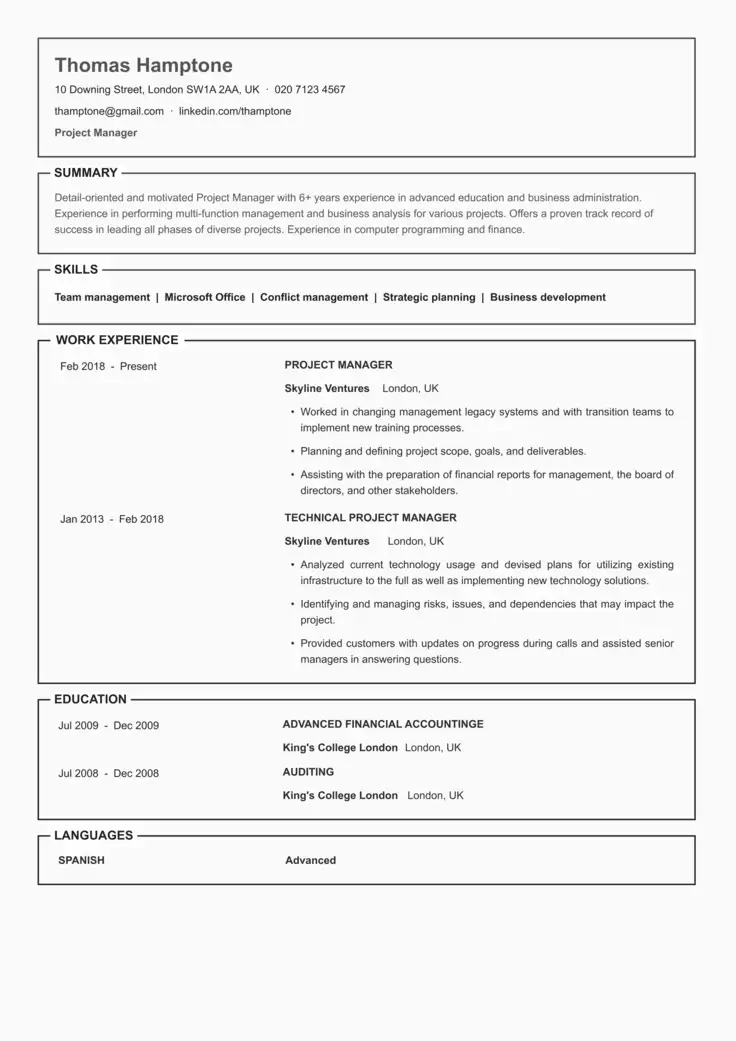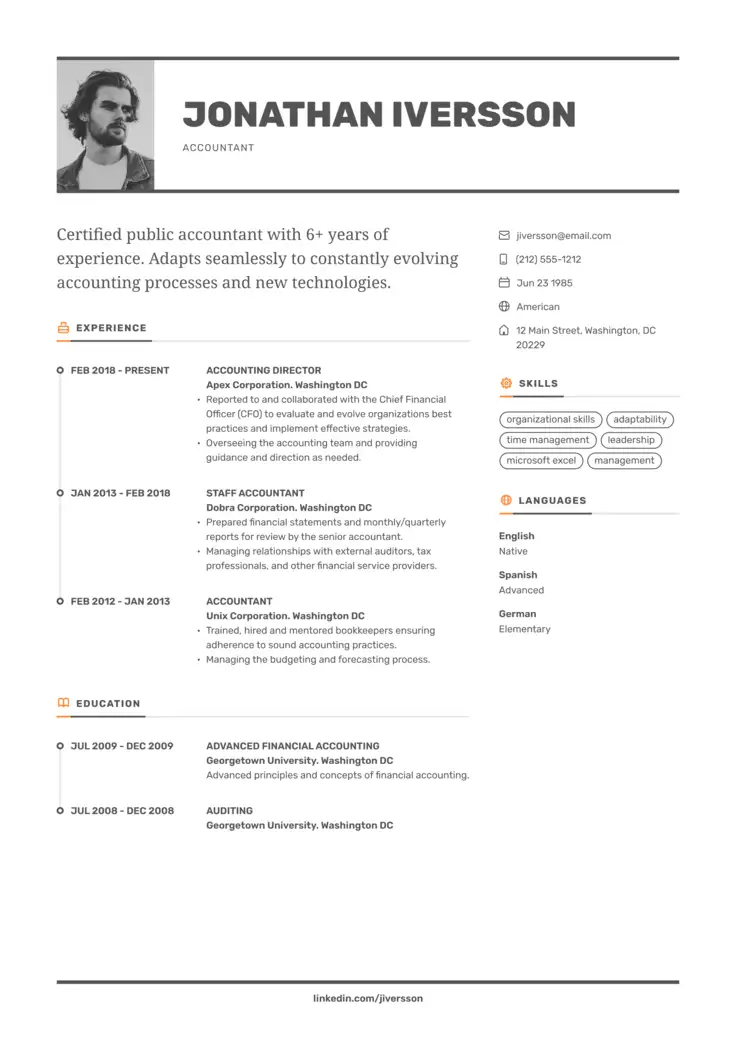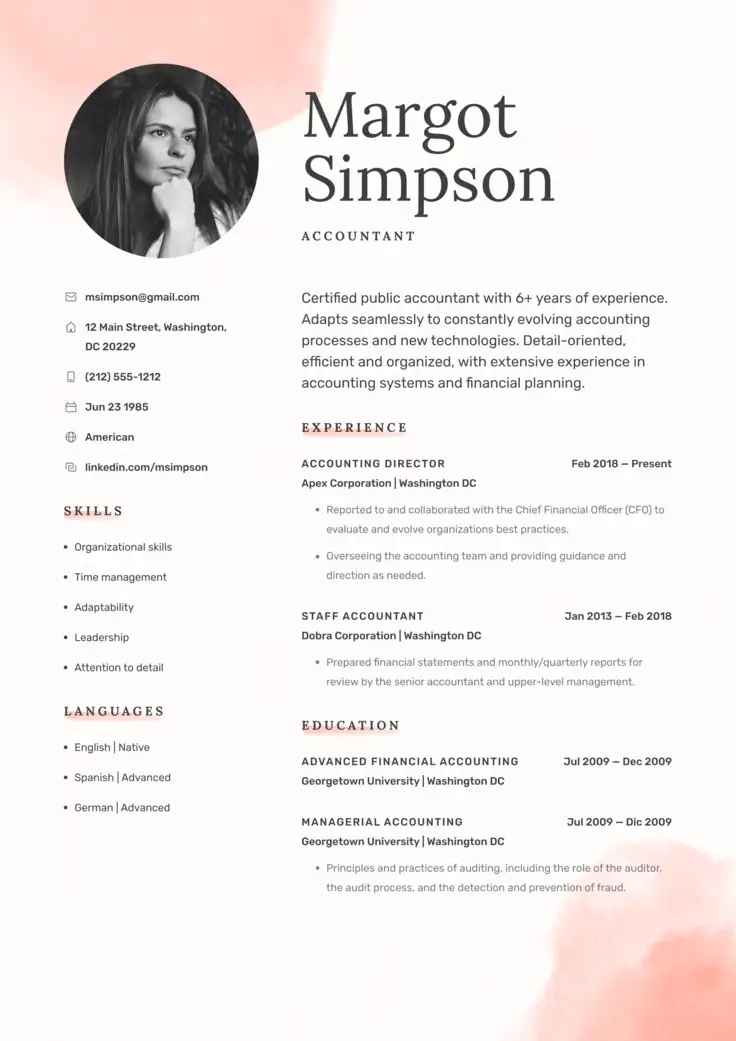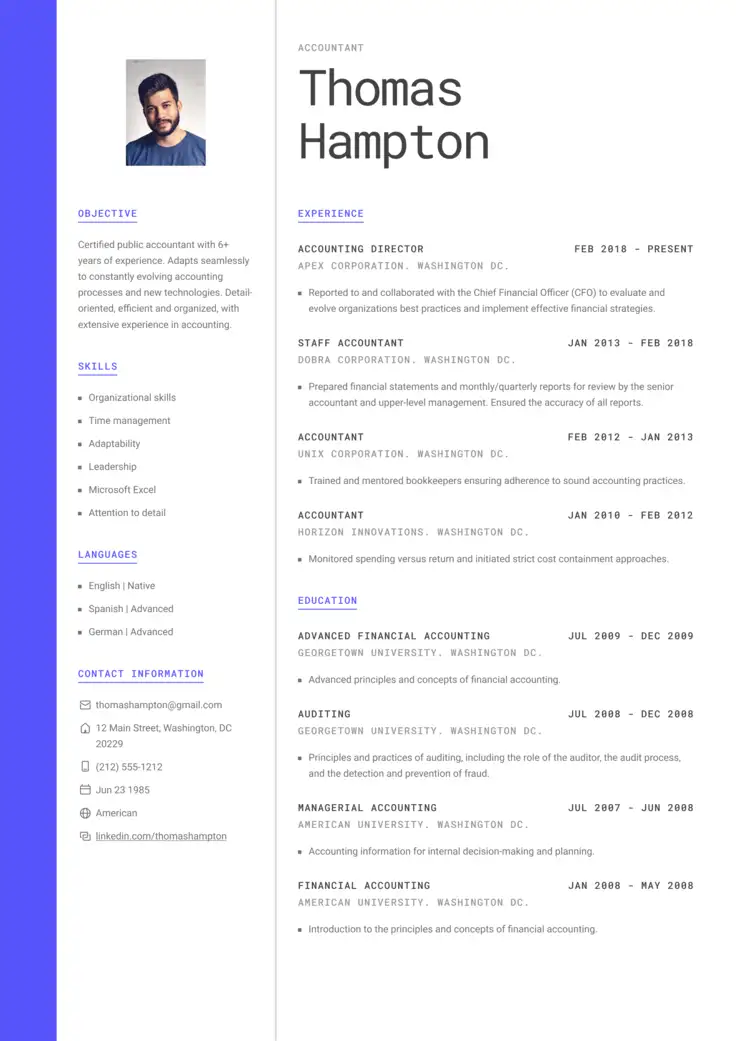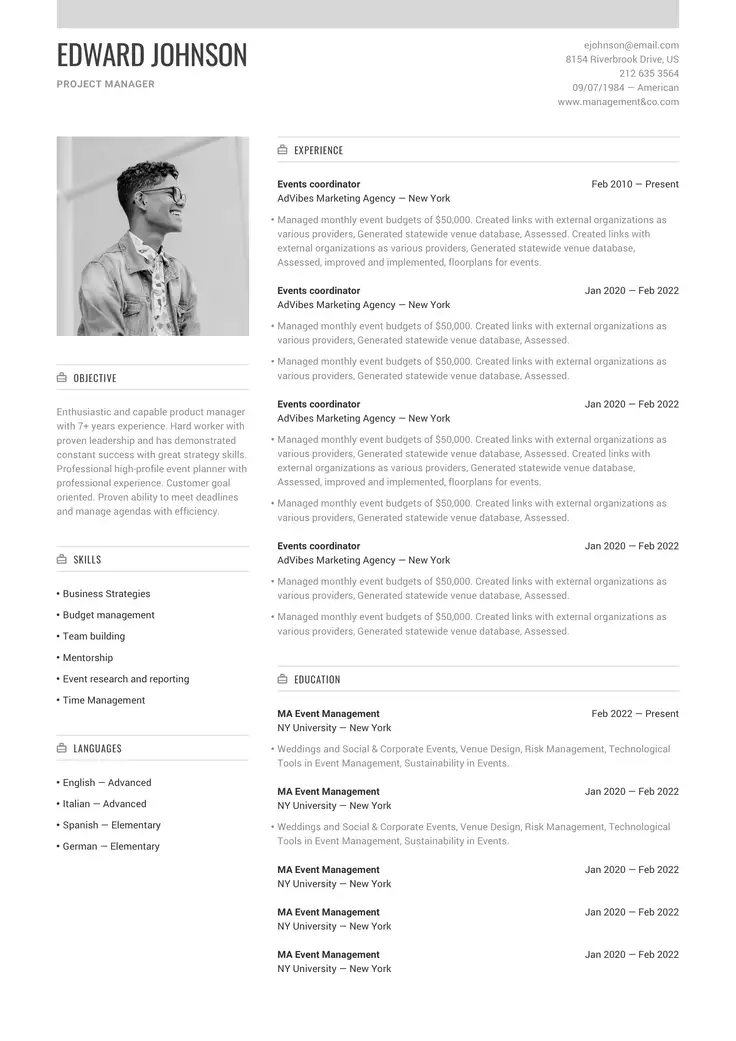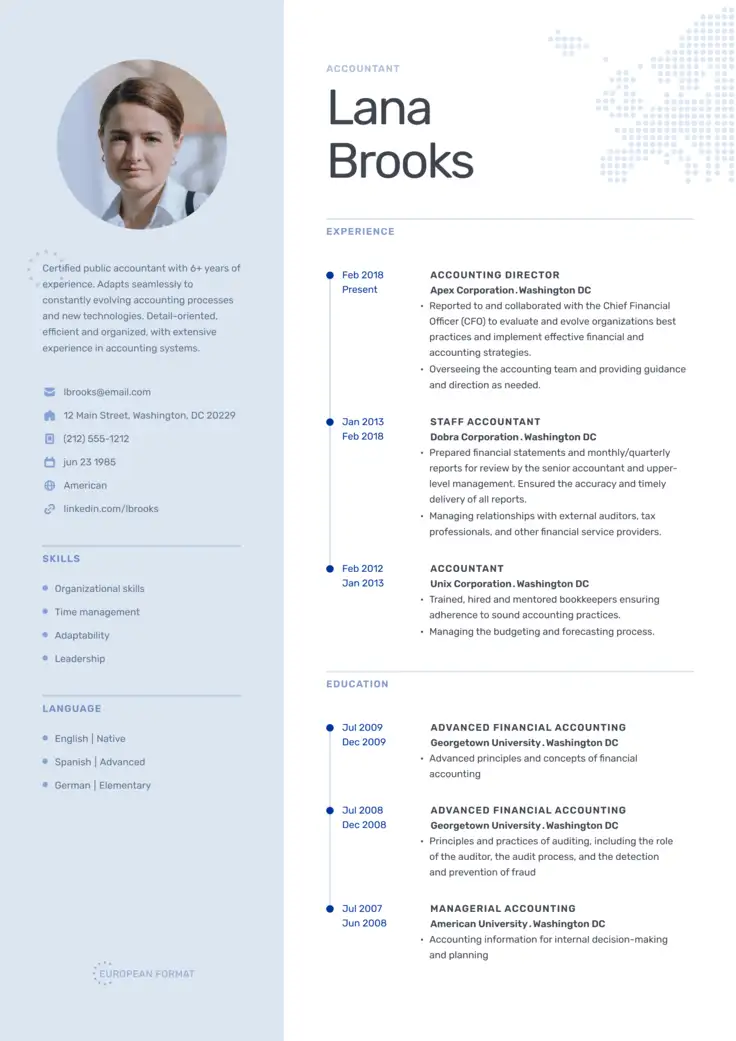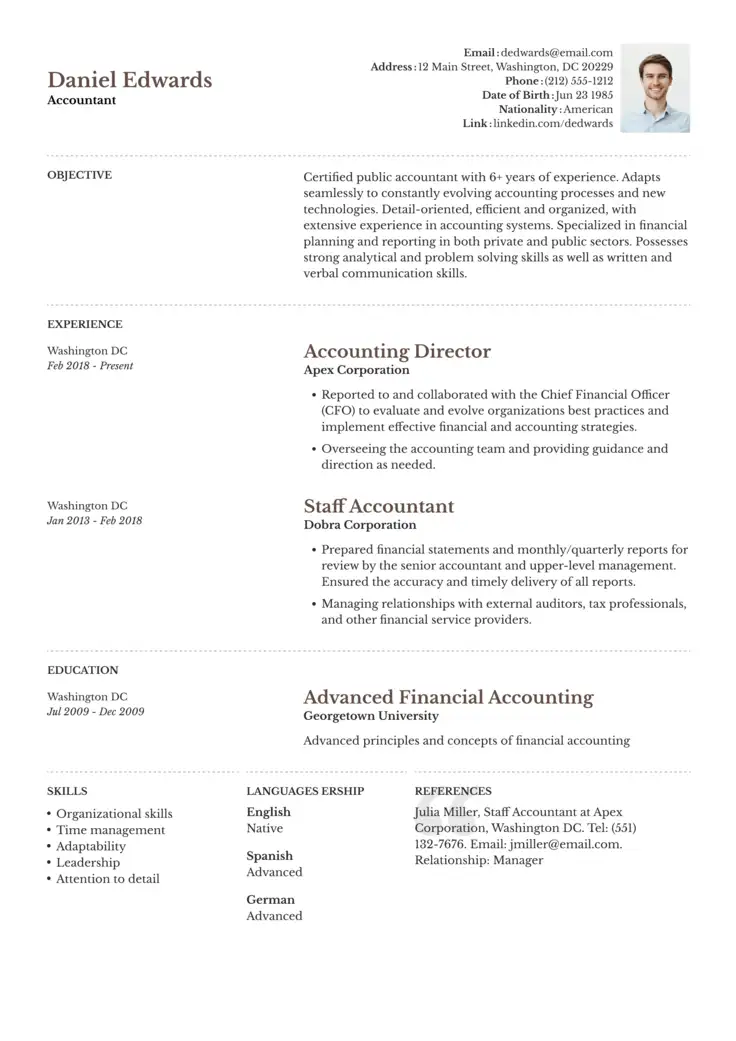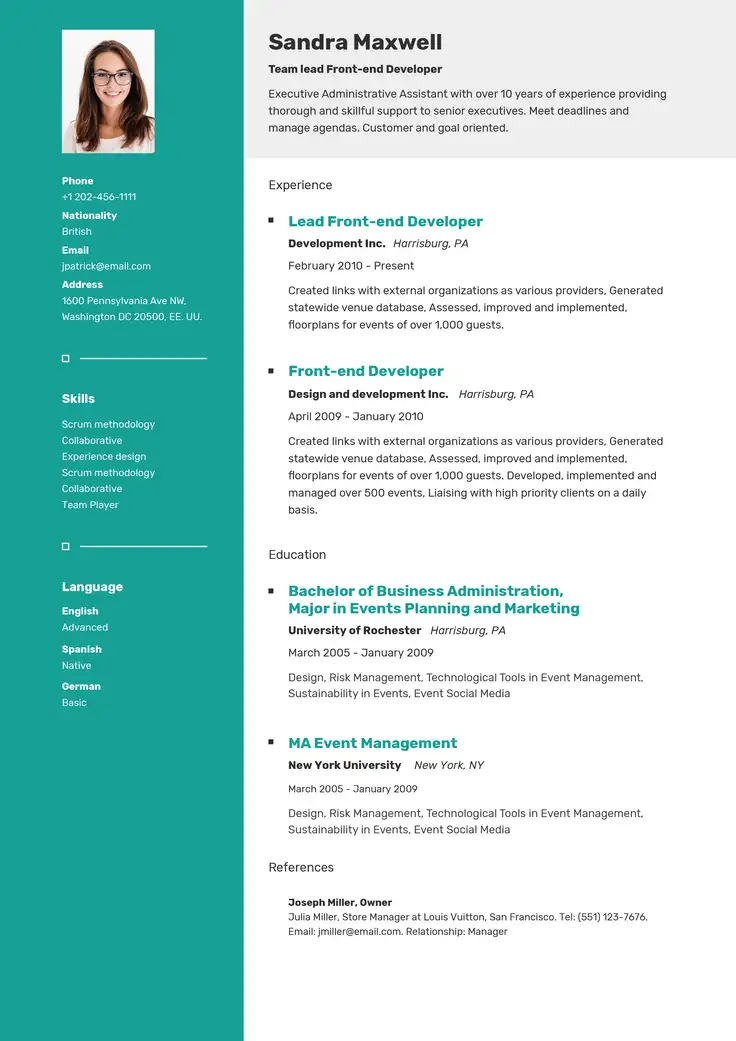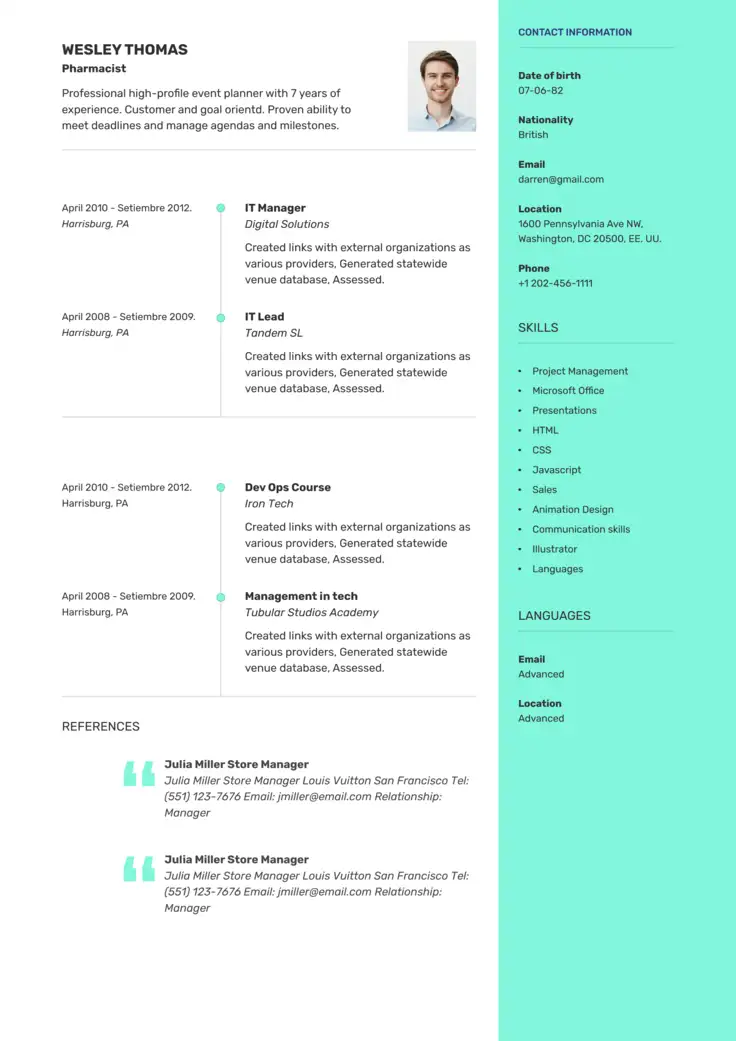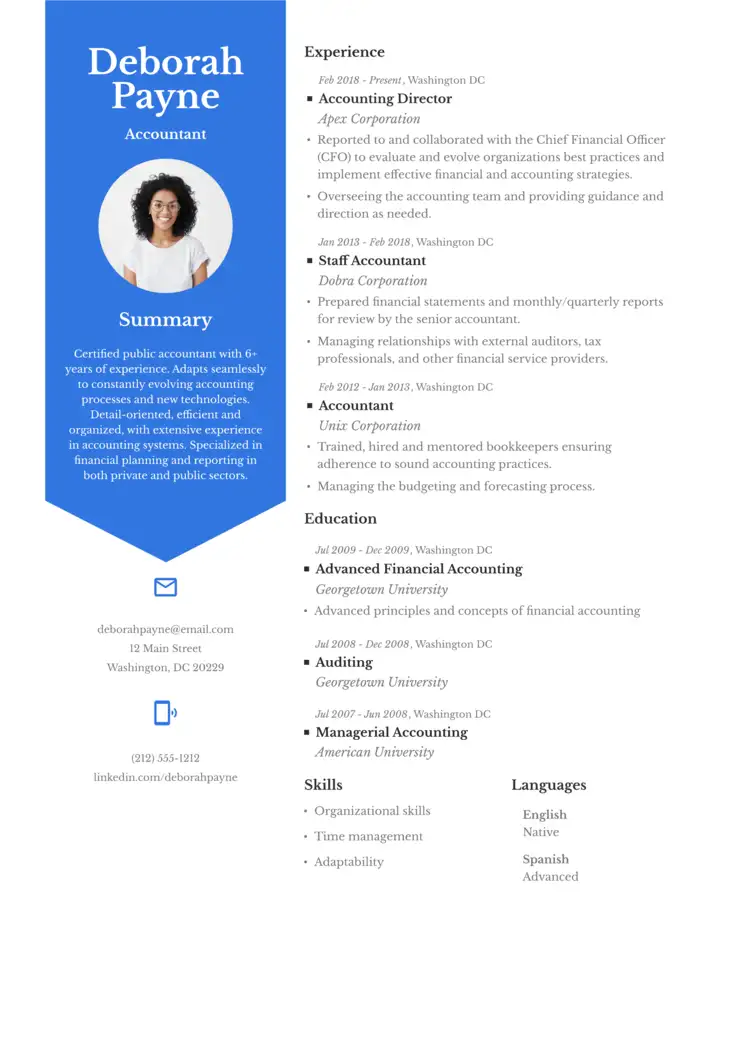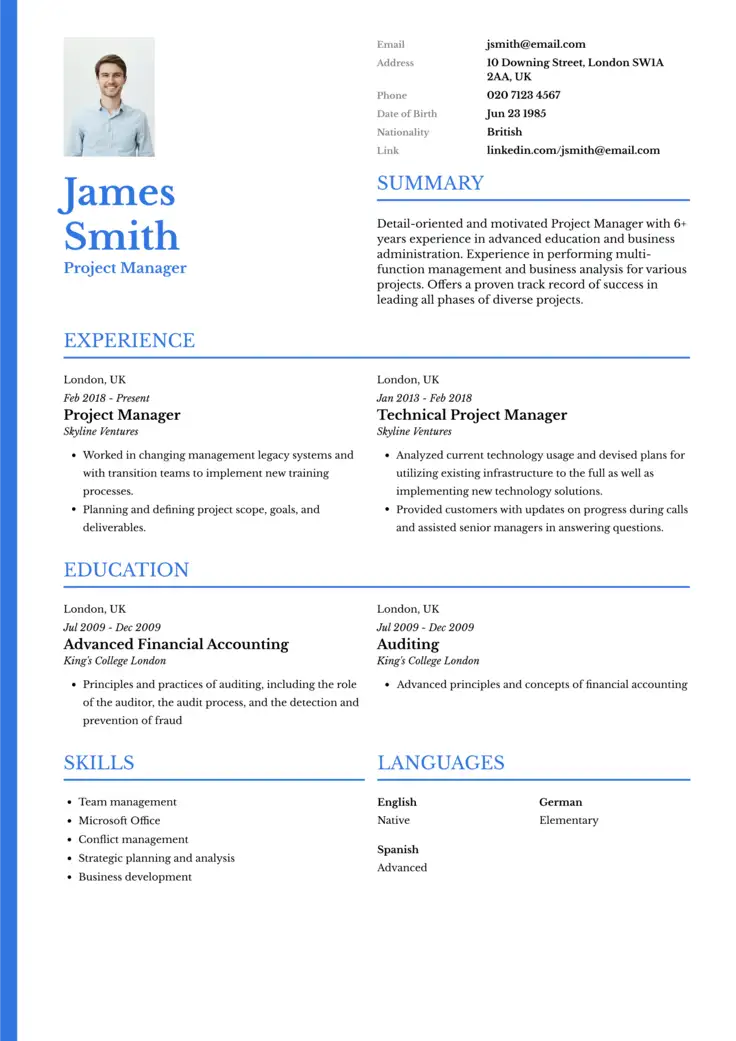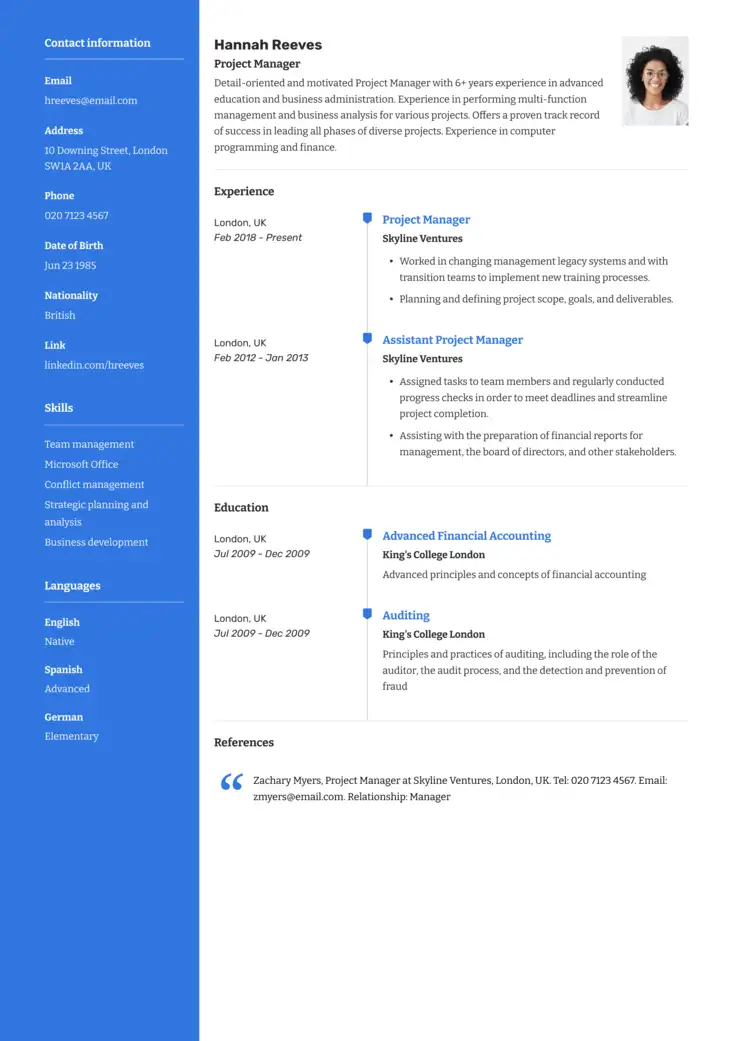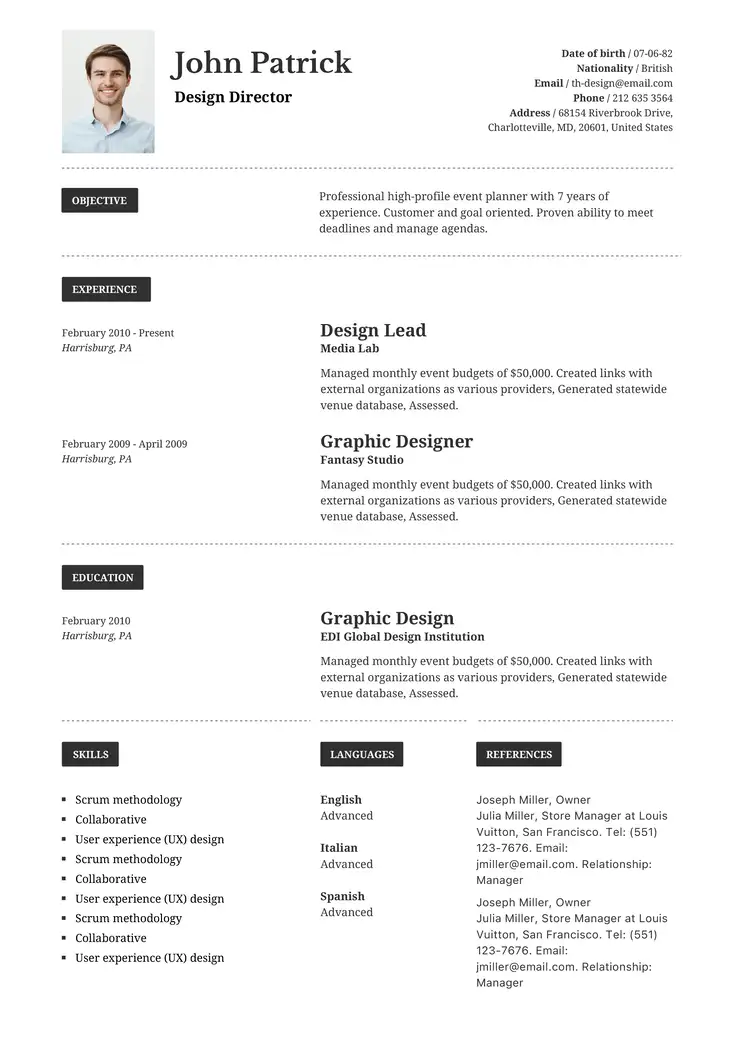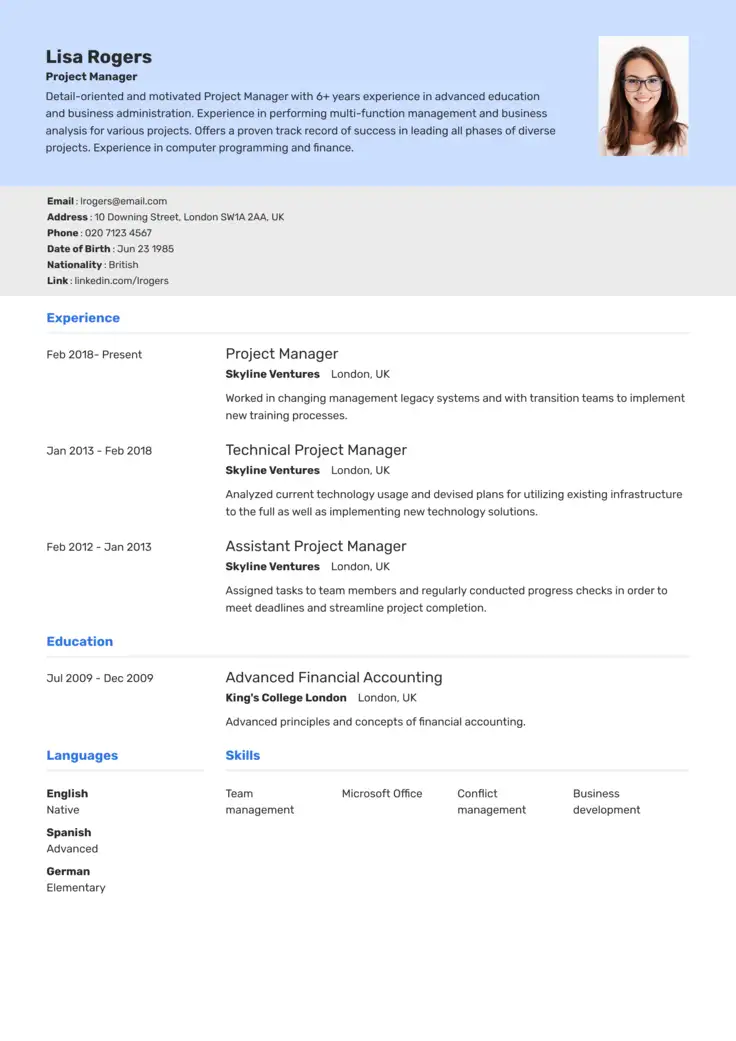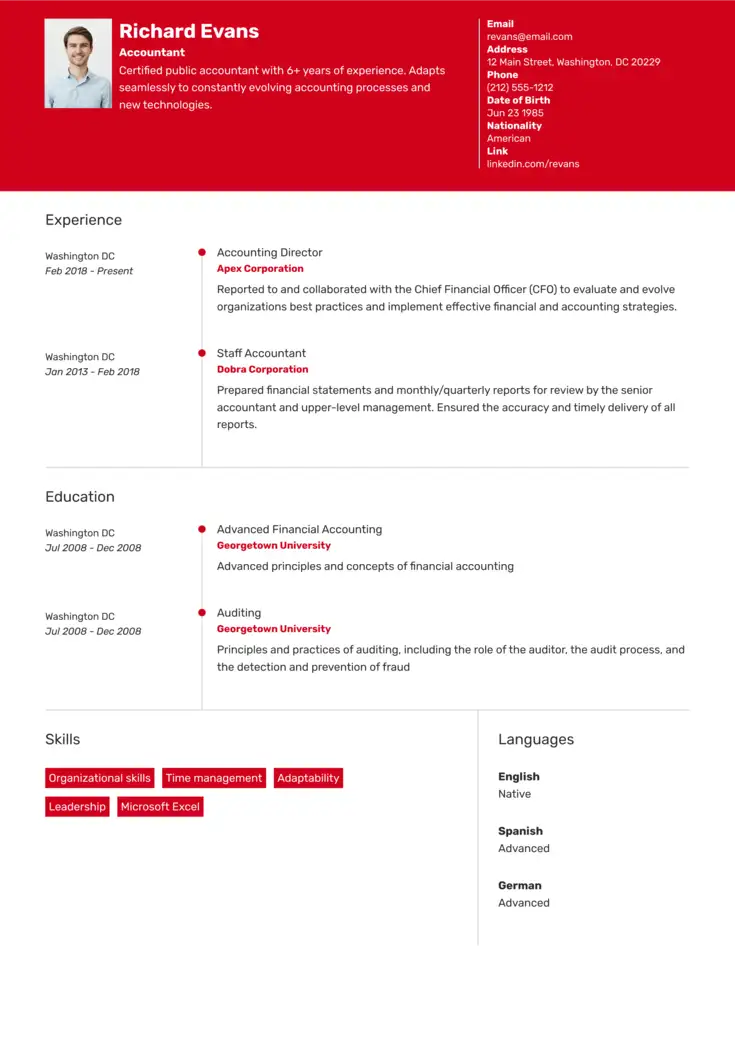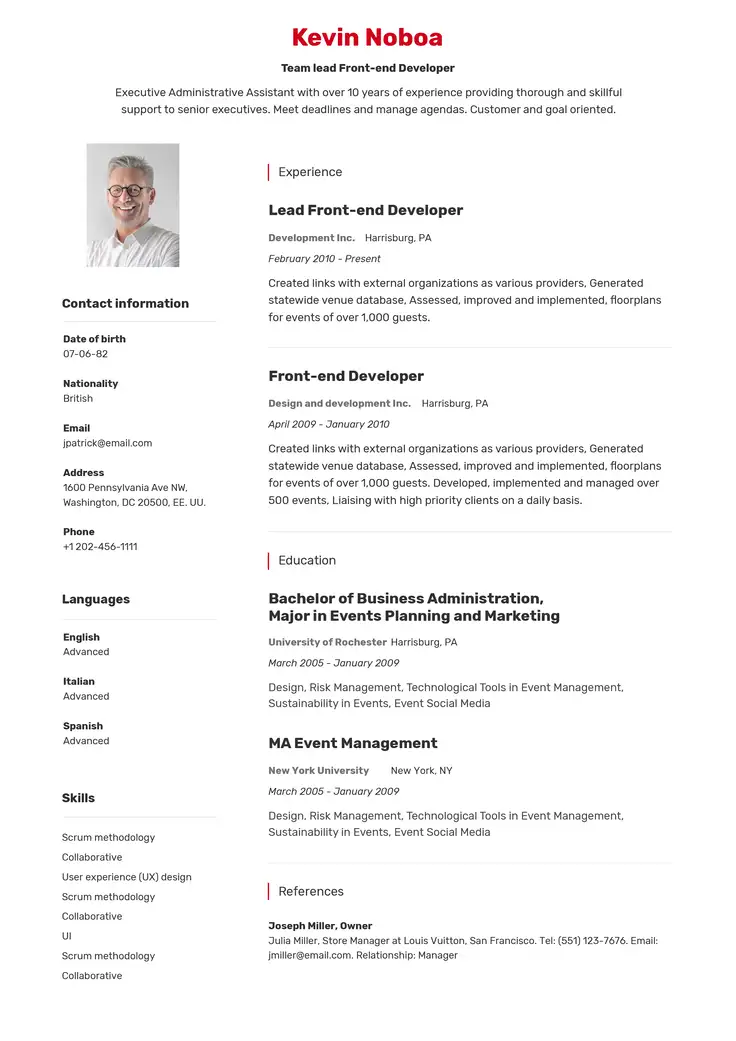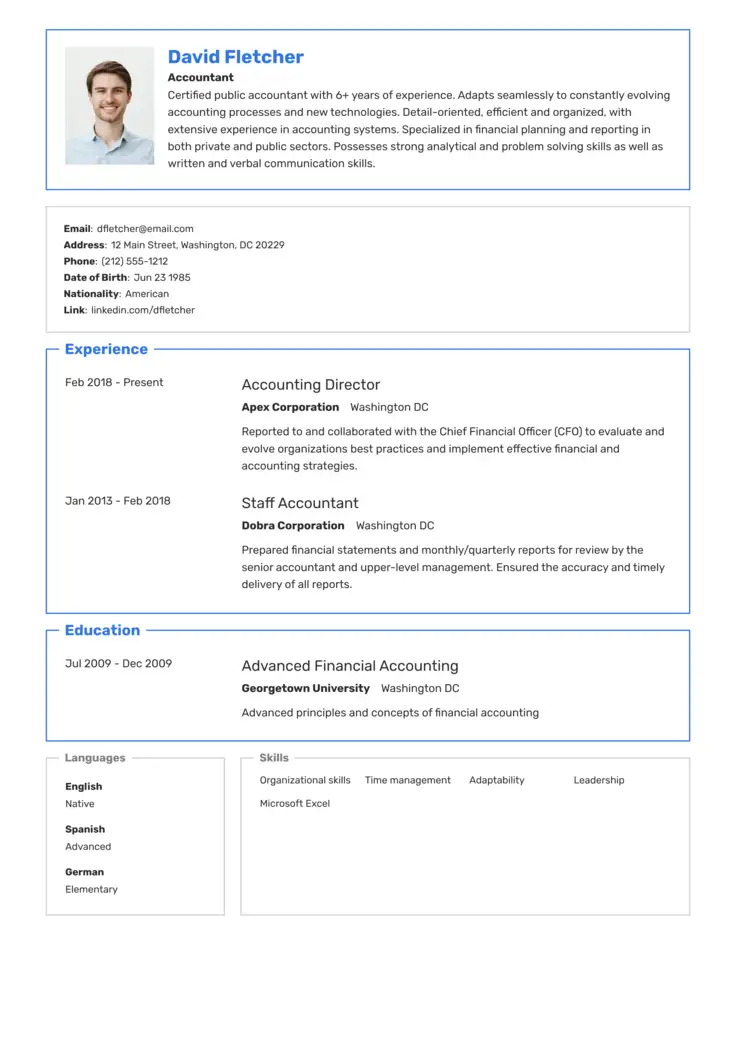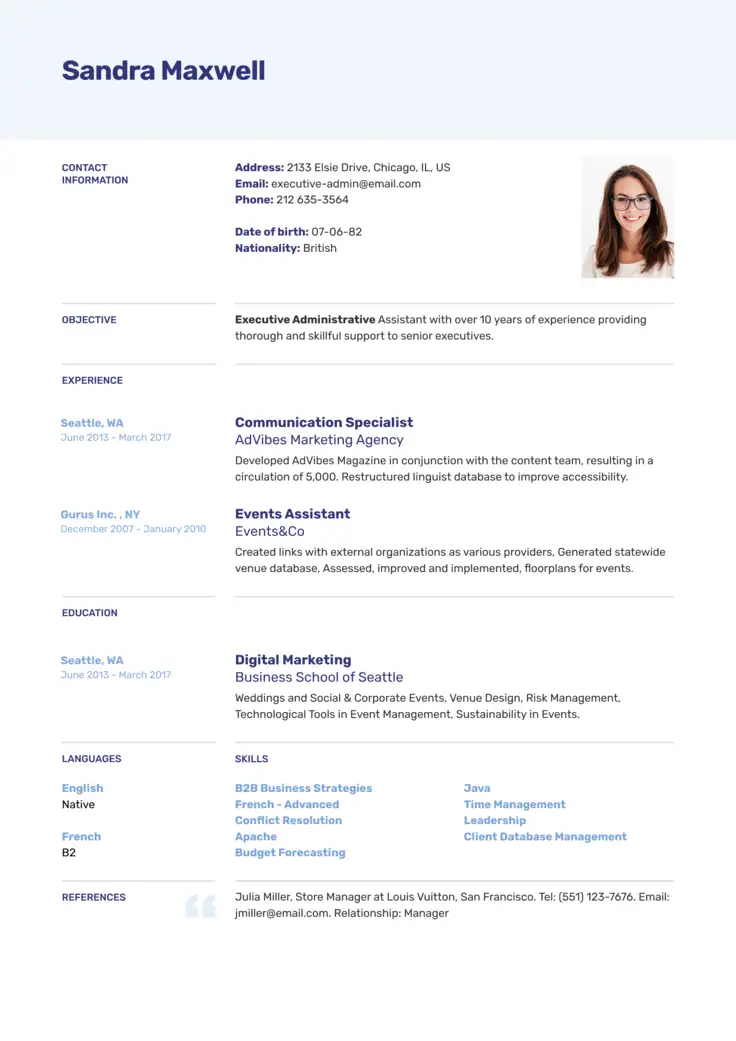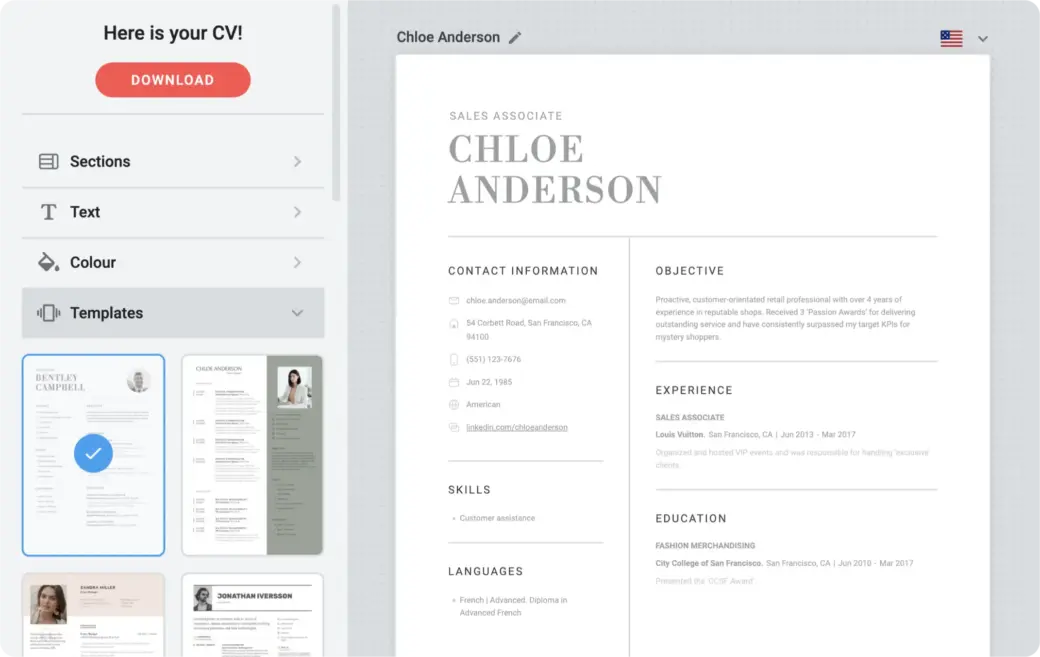
The Spanish Resume
Step into the world of Spanish-speaking job markets with confidence by writing a resume that resonates with local recruiters. This article provides a roadmap to understanding cultural subtleties and perfecting your resume’s layout for maximum impact.
Use our online editor to create the perfect spanish resume
Impress spanish employers and recruiters with our professional templates
With approximately 500 million native Spanish speakers globally and 13% of the U.S. population speaking Spanish, writing a Spanish resume is crucial for job seekers in Spanish-speaking markets.
This guide outlines how to write a Spanish resume—or CV, as it’s known in Europe—to meet the specific requirements of different countries, whether you’re targeting opportunities in the U.S. or abroad.
You’ll learn essential tips and expert advice to ensure your resume aligns with local recruitment practices, enhancing your candidacy.

Writing a Resume in Spanish
If you need to write a resume in Spanish, go beyond simply translating the information. Instead, you should try to write your Spanish CV from scratch, taking into consideration the differences in layout and relevant details.
The principal elements that need to be taken into account are:
- Formatting
- Information to include
- Order and importance of sections
- Cultural terms
- Equivalents for grades, courses, etc.
Below, you will find more information on these factors to help you structure and complete your resume in Spanish.
Let’s begin with some key tips.
1. Use bullet points
Sometimes, in resumes for the US or other countries, it is common practice to develop work experience descriptions or other sections in paragraph format.
In a Spanish curriculum this is not the case, and in any areas where you include more information than just basic details of dates and names, you should aim to use bullet points to list the corresponding description.
2. Use action verbs
Throughout a Spanish resume, candidates should make their achievements and key skills clear by using different action verbs.
Examples of good Spanish resume vocabulary to use include: prepare – preparar, achieve – lograr, obtain – conseguir, promote – fomentar, etc. Take a look at Spanish resume examples for more ideas.
💡Tip
The use of the Spanish equivalent of the first person singular ‘I’ – ‘Yo’ should be limited. Instead, simply use the past or infinitive form of the verb to explain accomplishments or responsibilities from previous experiences.
3. Ask for help
Once you’ve finished your Spanish resume and you’ve included all the relevant information without overloading it, it is highly recommended that you ask a native speaker to proofread the finished product.
Spanish may be a foreign language to you, but the hiring manager will spot mistakes in an instant. Any spelling or grammar mistakes could potentially ruin your chances of making it to the interview stage.
Spanish Resume: Layout and Sections
When it comes down to structuring a Spanish resume, applicants need to take a look at the Spanish resume format to understand what information should be included, and what should be excluded.
One way to do this is to employ Spanish resume templates that are pre-structured in a format that Spanish-speaking recruiters know well, to offer them the information in an easily recognizable order.
- The general rule for the length of a Spanish resume is to maintain all the information within 2x A4 size pages maximum.
- The margins and white space on a Spanish curriculum should also be considered because the technical resume formatting for different language resumes can vary. In standard Spanish CVs, margins should measure 3 cm (just over 1 inch) from the top of the page and 2.5cm (1 inch) from each side.
- Another rule to consider when creating a correct Spanish resume format is the heading or title at the beginning of the page. The header should include the applicant’s full name and the relevant personal details.
Once you understand the format that is necessary for a Spanish resume to fit the criteria of Spanish employers, you can use a resume in Spanish example to see how you can adapt your resume to their requirements.
What to include in a Spanish resume
If you’re asking yourself, what should I include in my resume in Spanish, you’ve come to right section of this article.
Other than the language, additional factors must be considered when writing a resume in Spanish. These elements encompass what sections should appear on a Spanish CV to catch the hiring manager’s attention.
If the curriculum is not well-formatted and laid out in the corresponding order, you could easily find your Spanish resume being rejected from the very beginning. To ensure this doesn’t happen, follow these guidelines.
Photo
As is often the case with foreign job applications, the Spanish curriculum generally includes a passport-sized photo. The photo should show only the head and shoulders and should not be taken from another photo but be professionally shot for this purpose.
If you are uncomfortable including a photo on your Spanish resume, it is not compulsory, and the ‘anonymous CV’ is becoming increasingly accepted in Spanish companies, so it should not cause a problem.
However, candidates should be aware that traditionally Spanish-speaking recruiters are accustomed to seeing this photo as part of the professional profile of an applicant.
Personal Information
Datos personales
Either with the photo or in a header for your resume, you should include a section dedicated to contact and personal information for the hiring manager to be able to identify you and have your contact details to hand if they are interested in discussing your application further .
This area should include the candidate’s details as follows:
- Full name – Nombre completo (First and Last name = Nombre and Apellido).
- Full address or alternatively a general location such as the region or city where you’re
- looking to work – Dirección or Ubicación (Estado, Zona, Región, Ciudad).
- Email address – Correo electrónico.
- Phone number – Número de teléfono.
💡Tip
If requested by the employer, you might want to add your ID number that proves your right to work in the country to which you’re applying. In Spain this is called a NIE – numero de identidad extranjero – giving the bearer permission to be contracted and pay into the tax and social security system. Check the name and nature of this document if you’re applying to work in a different Spanish-speaking country.
Education/training
Formación Académica
The education or training section is often found in second place on a Spanish resume, especially for entry-level or student resume candidates. It is dedicated to demonstrating the candidate’s qualifications and certificates.
The information that should be included in this section includes the following:
- Name and type of qualification (where possible, offer the Spanish equivalent).
- Corresponding start and finish dates (If the course is still undergoing, use the term ‘en curso’ to explain that the certificate has not yet been awarded).
- Location and/or academy name.
- Grade – if relevant (It is not necessary to include your GPA, but if you wish to add a grade to demonstrate high academic achievement, work out the equivalent for the country you’re applying to so the hiring manager has a frame of reference to understand the accomplishment better.)
If you have various diplomas, you should only include the most relevant and recent certifications to demonstrate to the prospective employer your training in the specific area you want to work in.
In a Spanish CV, if you have undertaken professional courses or training programs, these will usually be included in this section. It does not only refer to academic degrees.
If, like many job seekers these days, you have both professional and academic certificates, combine the most pertinent information regarding the different courses in this same section to provide a well-rounded image of your professional expertise to the hiring manager.
Professional Experience
Experiencia profesional
Usually in third position on a Spanish resume, the work experience section should give a list of the most recent and important positions you have held. To structure the job history section correctly, list previous posts in reverse chronological order.
Each entry in the work experience section should follow the same format:
- Name of position/Job title
- Company name or sector (If the company is unlikely to be known or understood, explain briefly the industry it is dedicated to.)
- Location
- Dates of employment
- Description of tasks and responsibilities
In addition to all paid professional experience, you should include internships and significant volunteer experience in this category. It is common practice to combine these various experiences rather than separate them into different areas.
Bear in mind that full dates must have the following format: DD/MM/YYYY.
Remember to include only the most relevant job history that relates directly to the company, industry, or position you’re applying to.
Skills
Competencias/Aptitudes
The most essential skills that you should mention in this section are those that establish you as the ideal applicant for the position in question. The best way to know what these skills are is by researching well the vacancy on offer and using the job description as a guide to find the key skills required.
Some of the most crucial skills to highlight on a Spanish resume include linguistic abilities and IT skills. If you are particularly gifted in one of these two areas, you can create a separate section that deals with just these capabilities.
💡Tip
If it is not relevant to the position you are applying for, it is not necessary to include a section dedicated to your IT skills. An exception would be if it offers something to your application that competing candidates might not have, which could be useful to the vacancy or company.
Languages
Idiomas
If you choose to add your linguistic abilities to a specially dedicated languages section or include them within your general skills section, you should remember to list not only the language you master but also the level to which you are able to use it in a professional capacity.
For a resume for Spain, candidates are recommended to list their linguistic abilities according to the Common European Framework of Reference (CEFR) for languages, which rates the level of fluency between a scale of A1 (most basic knowledge) to C2 (native fluency).
If you have completed any universally recognized exams, such as a DELE (Diploma de Español como Lengua Extranjera = Diploma of Spanish as a Foreign Language), these should be included in this section. This will allow the hiring manager to gain a better understanding of your level.
You can also use a more global scale if you are applying to work in a Spanish company in the US or elsewhere. The following are some general terms to describe linguistic abilities:
- Beginner – Inicial/Principiante
- Elementary – Básico
- Intermediate – Intermedio
- Advanced – Avanzado
- Bilingual – Bilingüe
- Mother tongue – Lengua materna
Hobbies
Aficiones
Only around 30% of Spanish recruiters favor a section on interests and hobbies, but it is still sometimes sensible to include one. This segment can give a potential employer a better, more well-rounded idea of the applicant. Sometimes, it can even be the turning point, if the candidate adapts their resume well to the vacancy or specific company culture, encompassing shared values into the free-time activities mentioned here.
Do not add this section if you feel it does not fit well with the type of position you are seeking or the specific business you’re applying to. The idea is not to waste a hiring manager’s time but to engage them with relevant information by supplying a well-structured and informative resume.
ResumeCoach is a multilingual online resume builder application that allows jobseekers to create resumes in various languages. Try it now and get a jumpstart on your Spanish resume with expert tips.
Additional Information
Información adicional
In this section, you can add information regarding your availability, your driving license type, or other major certificates you may hold that could be beneficial to your job application.
Spanish Resume Example
To create an eye-catching resume, use a Spanish resume example for guidance. This can help you select relevant sections, format your resume effectively, and incorporate common terms and phrases used by Spanish-speaking recruiters.
[Lucía Fernández López]
[Solicitando el puesto de Asistente de Investigación]
Datos de contacto
[Calle Gran Vía, 15, 28013, Madrid]
Email: lucia.fernandez.lopez@gmail.com
Teléfono: 612 345 7XX
LinkedIn: linkedin.com/luciafernandezlopez
Perfil profesional
Graduada en Biotecnología con un Máster Universitario en Investigación Biomédica, buscando su primera experiencia profesional remunerada. Tras haber realizado mis prácticas en el Instituto de Investigación Biomédica de la Universidad Complutense, me gustaría tener la oportunidad de ampliar mis conocimientos laborales y aprender de destacados profesionales en el campo.
Experiencia laboral
Asistente de investigación (prácticas)
Instituto de Investigación Biomédica, Madrid
Octubre 2022 – junio 2023
- Manejo de equipos de laboratorio avanzados
- Colaboración en proyectos de secuenciación genética
- Gestión y análisis de muestras biológicas
- Desarrollo de tareas en entorno de investigación regulado
- Análisis de datos para la mejora de procesos experimentales
Formación académica
Máster Universitario en Investigación Biomédica
Universidad Complutense de Madrid, Madrid
Septiembre de 2021 – junio de 2023
Grado en Biotecnología
Universidad Autónoma de Madrid, Madrid
Septiembre de 2017 – junio de 2021
Habilidades y aptitudes
- Análisis de datos e información
- Optimización de procesos y recursos
- Persona dinámica, proactiva, cooperadora y responsable
- Experiencia en trabajo en equipo y enfoque en objetivos
- Capacidad de organización de tiempos y tareas
Idiomas
- Nivel nativo de español
Información adicional
- Permiso de conducir
- Vehículo propio
In addition to reviewing resume examples in Spanish and using a Spanish resume template, candidates are also advised to examine cover letter samples which are better known as cartas de presentación.
To complete a job application for a vacancy in Spain, Mexico, or another Spanish-speaking nation or company, you’ll need to present both a Spanish curriculum and a cover letter.
Resume in Spanish for Mexico
When writing a resume for a job application in Mexico, it’s important to tailor it to meet local expectations rather than simply translating your existing resume.
In Mexico, a resume is commonly referred to as a CV or currículum and is similar to those used in Spain or the hoja de vida in other Latin American countries.
Education is highly valued in Mexican resumes and should be detailed, including college activities, honors, and awards.
Unlike some other countries, Mexican resumes may include a separate section called “Actualizaciones” for updates. Instead of adding new courses, professional training sessions, or diplomas to the education section, they should be listed here under this heading.
For a polished and culturally appropriate resume, consider using an online resume builder to streamline the process and ensure that your application aligns with Mexican standards
FAQs
When creating a resume for a job in a different country or language, it’s important to consider cultural differences beyond just translation. Both Spanish and American resumes are typically short, not exceeding 2 A4 pages.
However, Spanish resumes often contain less detail, as listing achievements and responsibilities have only recently become common. Additionally, including a skills section is a newer trend in Spanish resumes, often resulting in less detail than American resumes.
A work resume in Spanish, or currículum vitae, typically includes personal information such as name, contact details, and a photo. It often starts with a professional summary, followed by sections on education, work experience, and skills.
It’s becoming less common to include age, nationality, and marital status. The format is usually concise and may include a section for languages spoken and additional courses or certifications.
To create a resume in Spanish, start by using the correct Spanish terms for each section, such as Datos Personales for personal details and Experiencia Profesional for work experience. List your education and work history in reverse chronological order, and include a professional photo.
Use bullet points to describe your skills and achievements, keeping grammar simple and sentences concise. Ensure your resume is free from spelling and grammatical errors by having it reviewed by a native Spanish speaker or professional translator.
When describing your Spanish language skills on a resume, specify your proficiency level using terms like básico (basic), intermedio (intermediate), avanzado (advanced), or nativo (native).
You can also use standardized levels such as A1-C2 from the Common European Framework of Reference for Languages (CEFR). Mention specific skills like speaking, reading, writing, and listening.
For a Spanish resume with no experience, focus on highlighting your education, skills, and any relevant extracurricular activities.
Start with a personal information section (Datos Personales), followed by education (Formación Académica), detailing your degree and institution. Include a skills section (Habilidades) to showcase language abilities, computer skills, or soft skills like communication. Use a resume template in Spanish for further guidance.
Add sections for volunteer work (Trabajo Voluntario) or internships (Prácticas), and consider including a brief personal statement (Perfil Personal) to convey your career goals and enthusiasm.

